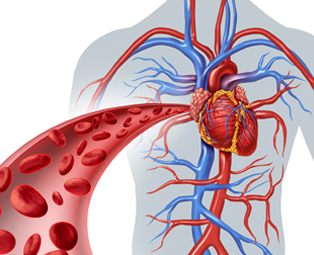Peripheral Vascular Clinic
 Peripheral vascular disease (PVD) is a disorder related to blood circulation. The condition causes the blood vessels outside the heart and brain to narrow, block, or spasm. This can happen in the veins or arteries. Peripheral vascular disease commonly causes pain and fatigue, often in the legs, and specifically during exercise. The pain generally improves with rest. It may also affect the vessels supplying blood and oxygen to arms, kidneys, and stomach and intestines. During the PVD, blood vessels become narrowed and blood flow decreases. This may be an outcome of arteriosclerosis, or hardening of the arteries, or can be due to blood vessel spasm.
Peripheral vascular disease (PVD) is a disorder related to blood circulation. The condition causes the blood vessels outside the heart and brain to narrow, block, or spasm. This can happen in the veins or arteries. Peripheral vascular disease commonly causes pain and fatigue, often in the legs, and specifically during exercise. The pain generally improves with rest. It may also affect the vessels supplying blood and oxygen to arms, kidneys, and stomach and intestines. During the PVD, blood vessels become narrowed and blood flow decreases. This may be an outcome of arteriosclerosis, or hardening of the arteries, or can be due to blood vessel spasm.
Types
There are two different types of conditions: Arterial and Venous.
Arterial Conditions
Peripheral arterial disease (PAD) is a chronic condition in which total or partial occlusion deprives the lower extremities of nutrients and oxygen. Common conditions cause blockage includes atherosclerosis, atheromatous plaques, thrombus, emboli or arterial spasm.
PAD doesn’t discriminate among its victims on the basis of age and gender, meaning it equally affects men and women. Common conditions related to PAD are:
- Heart Attack- permanent damage to the heart muscles commonly caused by a lack of blood supply
- Stroke- interruption of blood flow to the brain
- Transient Ischemic Attack- temporary interruption in the blood supply to your brain
- Amputation- the removal of part of the foot or leg, especially in patient who have diabetes
- Renal artery disease- a narrowing or blockages of the artery that supplies blood to the kidney
Symptoms of Arterial Conditions
- Painful cramping in the hip, thigh, or calf muscles after certain activities
- Coldness in the lower leg or foot
- Leg numbness or weakness
- Sores on the toes, feet or legs
- A change in the color of eyes
- Hair loss
- Shiny skin on the legs
- No pulse or weak pulse in the legs or feet
- Erectile dysfunction in males
Venous Conditions
Peripheral Venous Disease includes the kind of disorders that occur due to increased venous pressure or valve damage of a vein wall. The damage is often caused by:
- Inflammation
- Diminishes blood flow through stretching
- Dilation from defective vein walls
They may also result from preexisting conditions, such as obesity, CHF result in bilateral diseases. Common venous diseases are:
- Chronic Venous Insufficiency
- Chronic Venous Insufficient Varicose Veins
- Chronic Venous Insufficiency Ulcers
- Deep Vein Thrombosis Acute
Common Tests
Carotid Ultrasound: This ultrasound is usually performed to test the narrowed carotid arteries, which hike the risks of stroke.
[Know More]
Doppler Ultrasound: It’s a non-invasive test that can be performed to estimate the blood flow through the blood vessels by bouncing high-frequency sound waves off circulating red blood cells.
[Know More]
Venous Doppler: This blood uses ultrasound in order to look at the blood flow in the large arteries and veins in the legs and veins.
[Know More]

 9818646277
9818646277



 Peripheral vascular disease (PVD) is a disorder related to blood circulation. The condition causes the blood vessels outside the heart and brain to narrow, block, or spasm. This can happen in the veins or arteries. Peripheral vascular disease commonly causes pain and fatigue, often in the legs, and specifically during exercise. The pain generally improves with rest. It may also affect the vessels supplying blood and oxygen to arms, kidneys, and stomach and intestines. During the PVD, blood vessels become narrowed and blood flow decreases. This may be an outcome of arteriosclerosis, or hardening of the arteries, or can be due to blood vessel spasm.
Peripheral vascular disease (PVD) is a disorder related to blood circulation. The condition causes the blood vessels outside the heart and brain to narrow, block, or spasm. This can happen in the veins or arteries. Peripheral vascular disease commonly causes pain and fatigue, often in the legs, and specifically during exercise. The pain generally improves with rest. It may also affect the vessels supplying blood and oxygen to arms, kidneys, and stomach and intestines. During the PVD, blood vessels become narrowed and blood flow decreases. This may be an outcome of arteriosclerosis, or hardening of the arteries, or can be due to blood vessel spasm.
Follow Us On: